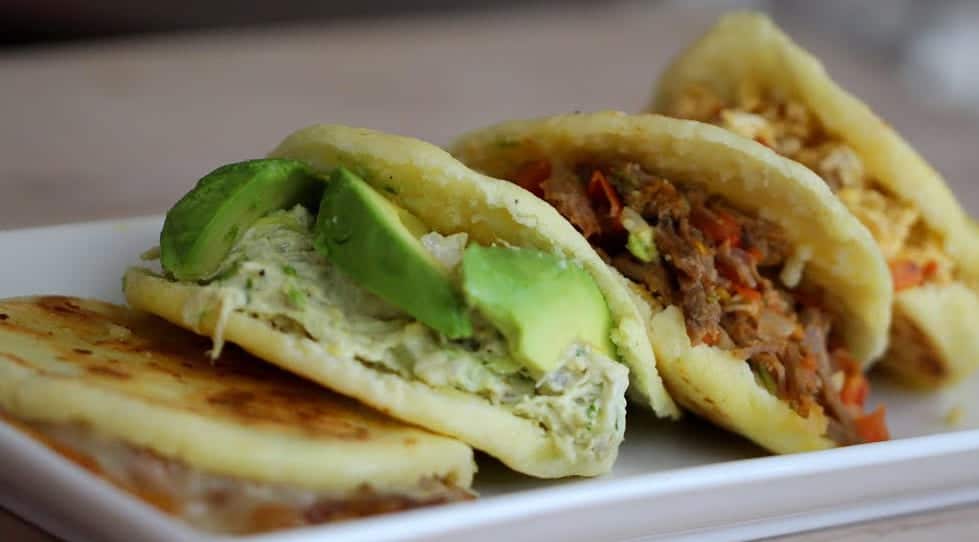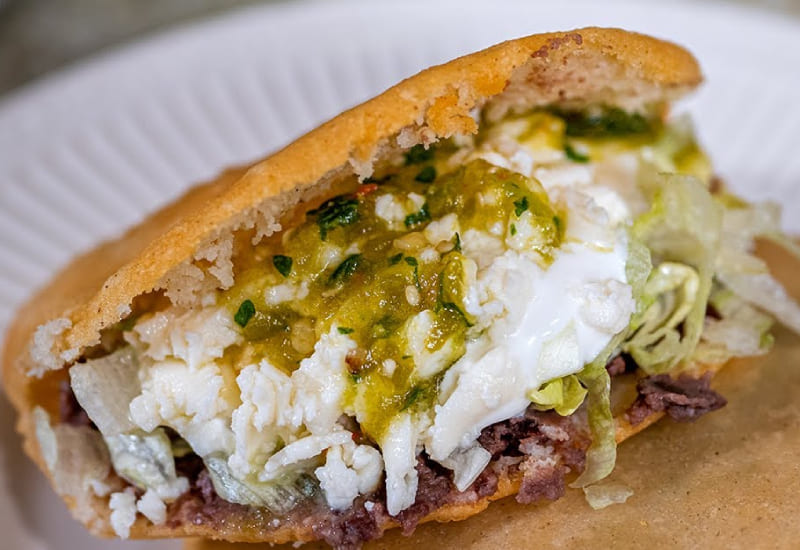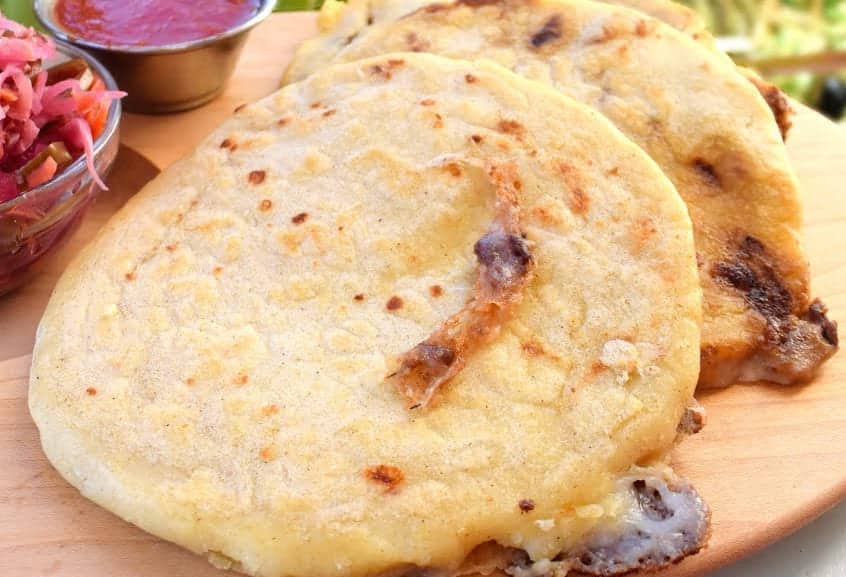Delicious Latin American Treasures: A Comparison of Arepas, Pupusas and Gorditas

Welcome to a gastronomic journey through the authentic flavors of Latin America! In this article, I invite you to explore arepas, pupusas and gorditas, true culinary gems that awaken the senses and fill the heart with nostalgia and joy. Learn the story behind each one of them, discover their exquisite ingredients and let yourself be seduced by their unique shape and irresistible texture. Get ready to enjoy a culinary experience that will transport you directly to the essence of Latin American cuisine. Let's unravel the secrets of these culinary treasures together!
- Origins and history: immerse yourself in the past full of tradition and culture.
- Ingredients and preparation: discover authentic flavors and traditional techniques.
- Shape and texture: a unique sensory experience in every bite
- Fillings and flavors: an explosion of flavors and options for all tastes
- Accompaniments and sauces: the perfect touch to enhance flavor
- Popularity and diffusion: a culinary legacy that has crossed borders.
Origins and history: immerse yourself in the past full of tradition and culture.
Arepas, pupusas and gorditas have deep historical roots that go back centuries. Each of them originated in different regions of Latin America, and their history is a reflection of the cultures and traditions of their respective countries.
Arepas, which originated in Colombia and Venezuela, date back to the indigenous civilizations that inhabited the region before the arrival of the colonizers. These corn tortillas became a versatile staple food, adapting to changes and evolving over time.
Pupusas, meanwhile, are a Salvadoran treasure believed to have originated in pre-Columbian times. These delicious stuffed corn tortillas have become an emblem of El Salvador's culinary identity, transmitting the region's indigenous and mestizo heritage.
Traditional Mexican gorditas have their origins in Mesoamerican civilizations, such as the Aztecs. These thick, soft tortillas have become a nationally recognized delicacy, with regional variations that reflect Mexico's culinary diversity.
Over the years, these delicacies have evolved and adapted to the tastes and needs of each region. Their popularity has spread beyond their countries of origin, conquering palates around the world and becoming ambassadors of Latin American gastronomy.

Ingredients and preparation: discover authentic flavors and traditional techniques.
Each of the arepas, pupusas and gorditas has its own combination of ingredients and preparation techniques that make them unique and delicious. Dive into this culinary journey and discover the secrets behind their creation.
Arepas, made mainly with corn flour, are the result of a special dough mixture that is kneaded and cooked on a griddle or frying pan. Depending on the region, they may have different types of fillings such as cheese, meat, chicken or vegetables, which are added before the arepa is closed and cooked. The result is a delicious combination of crunchy on the outside and soft on the inside.
Pupusas, on the other hand, are made with corn dough that is filled with a variety of ingredients such as cheese, beans, meat or vegetables. The preparation technique consists of forming a kind of stuffed tortilla that is cooked on a hot griddle. The result is a pupusa that is golden and crispy on the outside, with an interior full of irresistible flavors and textures.
Gorditas, known for their thicker and spongier dough, are made with corn flour or corn masa mixed with other ingredients such as lard or wheat flour. The dough is formed into small balls that are flattened and cooked on a griddle or comal. Once cooked, they can be filled with a variety of ingredients such as meat, beans, cheese or salsa.
Each of these delicacies requires skill and patience to achieve the perfect combination of flavors and textures. The choice of ingredients and the preparation technique are fundamental to obtain the desired result. Through generations, these recipes have been passed on by word of mouth, preserving the essence of traditional Latin American cuisine.

Shape and texture: a unique sensory experience in every bite
Arepas, pupusas and gorditas are not only known for their flavors, but also for their distinctive shape and texture. Each one of them offers a unique sensory experience that captivates those who venture to try them.
Arepas, for example, are round and flat, ranging in size from small and thick to larger and thinner. Their texture is crunchy on the outside, the result of cooking on the griddle, while the inside is soft and spongy. Biting into an arepa triggers a combination of sensations: the initial crunch followed by the softness of the dough and the explosion of flavors from the filling.
Pupusas, on the other hand, have a shape similar to a thick, round tortilla. Their texture is different, with a crispy, golden outer layer that contrasts with a soft, slightly elastic interior due to the filling and dough. When tasting a pupusa, you can enjoy the combination of textures: the resistance when biting into it followed by the mixture of flavors and textures of the melted filling.
Gorditas, as their name suggests, have a rounder and thicker shape. Their texture is dense and slightly crunchy on the outside due to the cooking on the griddle, but at the same time spongy and soft on the inside. Each bite of a gordita offers a comforting experience, with a mix of textures that complement each other perfectly.
The shape and texture of these culinary delights are an integral part of their charm. Each bite is a tactile and gustatory experience that transports diners to the corners of Latin America. The combination of softness and crunch, along with the flavors and fillings, creates a symphony of sensations that leaves a lasting impression on the palate.
Fillings and flavors: an explosion of flavors and options for all tastes
One of the most exciting features of arepas, pupusas and gorditas is the wide variety of fillings and flavors that can be enjoyed. Each of these delicacies offers traditional and popular options that delight palates and satisfy all tastes.
In the case of arepas, the fillings are practically infinite. From classic Venezuelan white cheese to juicy strips of Colombian shredded beef, shredded chicken, black beans, avocados and a variety of fresh vegetables. Flavors range from salty and smoky to spicy and slightly sweet. Each bite is an explosion of flavors that combine in harmony with the softness of the dough.
Pupusas also offer a wide range of traditional fillings, such as cheese (like Salvadoran quesillo), refried beans, chicharrón (fried and shredded pork) and loroco (an edible flower). In addition, you can find pupusas revueltas, which combine different ingredients in a single filling. The flavors are rich and authentic, full of spices and seasonings that highlight El Salvador's culinary identity.
Mexican gorditas are famous for their varied and tasty fillings. You can find gorditas filled with shredded pork (carnitas), refried beans, cheese, chicharron, picadillo (ground beef with potatoes and carrots) and many other options. The flavors are vibrant, with influences from Mexican cuisine, such as the use of chiles, cilantro, onion and a wide range of spices that bring each bite to life.
The versatility of arepas, pupusas and gorditas allows them to adapt to individual tastes and preferences. You can experiment and create your own combinations of fillings, exploring new flavors and textures. These culinary delights offer a range of possibilities to enjoy a personalized and unique gastronomic experience.
Accompaniments and sauces: the perfect touch to enhance flavor
When it comes to enjoying arepas, pupusas and gorditas, side dishes and sauces play a crucial role. These complementary elements add an extra touch of flavor and enhance the dining experience.
Arepas are wonderful on their own, but they become even more delicious when accompanied by sauces and toppings. You can find a variety of options, such as guasacaca (an avocado-based sauce), garlic sauce, hot bell pepper sauce or even the classic tomato sauce. These sauces add freshness, creaminess and a spicy touch that combines perfectly with the texture and flavor of the arepas.
In the case of pupusas, the accompaniments usually include curtido (a pickled cabbage salad), red tomato salsa and salsa criolla. The curtido adds a refreshing acidic flavor that balances the more intense flavors of the pupusas, while the salsas add a touch of spice and highlight the traditional ingredients and flavors.
As for gorditas, the accompaniments may vary according to the region and the type of filling. Some popular options include sauces such as salsa verde (made from tomatillos), salsa roja de chile de árbol or salsa de aguacate. These sauces provide an explosion of intense flavors that blend perfectly with the masa and gordita fillings.
In addition to sauces, you can also add ingredients such as grated cheese, sour cream, lemon slices or fresh herbs to further enhance the flavors and add layers of texture and freshness.
The accompaniments and sauces are like the magic touch that elevates arepas, pupusas and gorditas to another level of flavor and enjoyment. Each bite is enriched by the combination of flavors and the mix of textures, creating a complete and satisfying culinary experience.
Popularity and diffusion: a culinary legacy that has crossed borders.
Arepas, pupusas and gorditas have transcended their countries of origin to become authentic ambassadors of Latin American gastronomy around the world. Their popularity and diffusion have grown exponentially, conquering the palates of people of different cultures and nationalities.
Arepas have gained international recognition and have become a culinary symbol of Colombia and Venezuela. Restaurants specializing in arepas have sprung up in several countries, taking this iconic dish to faraway places. There have even been festivals and gastronomic events dedicated exclusively to arepas, celebrating their versatility and authentic flavors.
Pupusas, meanwhile, have captivated the hearts of Salvadoran food lovers around the world. Salvadoran restaurants have flourished in different countries, offering pupusas as the star dish on their menus. Their unique flavor and the tradition surrounding them have attracted curious people who wish to experience authentic Salvadoran cuisine.
Mexican gorditas have also transcended borders and have earned a special place in international palates. The authentic flavors and diversity of fillings have attracted people eager to try authentic Mexican food. You can even find Mexican food trucks and restaurants in many cities around the world offering gorditas as a delicious and popular option.
The dissemination of these culinary delights has been facilitated by the growing presence of Latin American gastronomy on the international scene. Television programs, social networks and travel have allowed for greater exposure of these traditional foods, arousing the curiosity and interest of people from different cultures.
The popularity and spread of arepas, pupusas and gorditas are a testament to the universal love of good food and the ability of culinary traditions to connect people. These dishes have managed to transcend geographical and cultural barriers, finding a special place in the hearts and palates of those who venture to try them.
If you want to know other articles similar to Delicious Latin American Treasures: A Comparison of Arepas, Pupusas and Gorditas you can visit the category nutrition.

